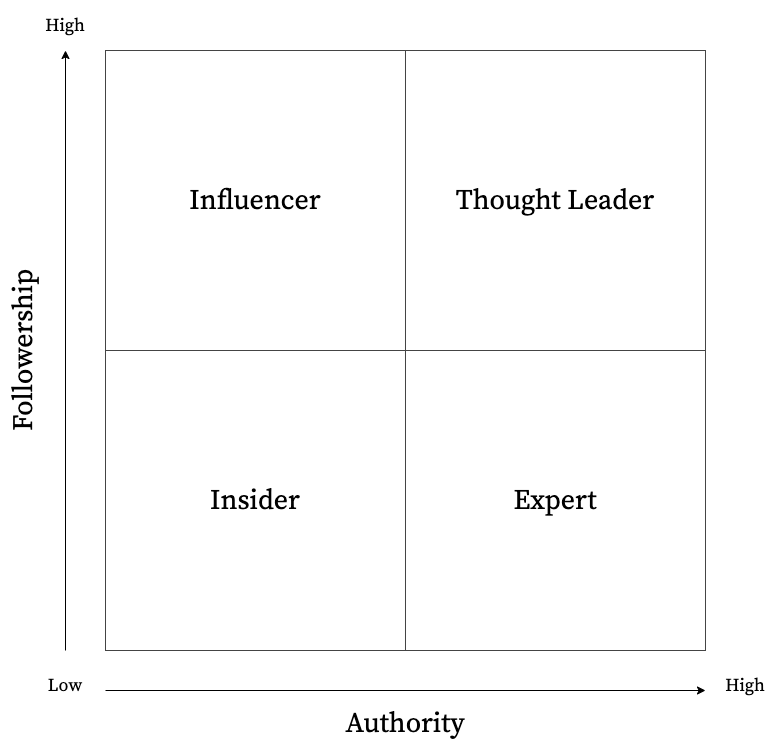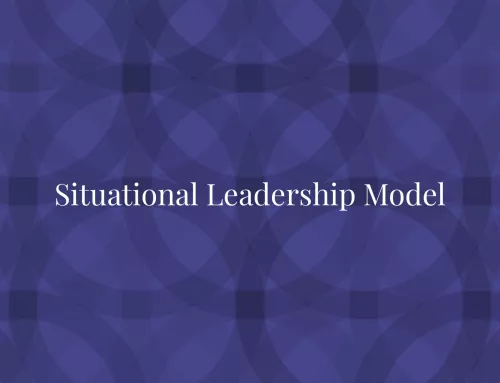A Thought Leader is a person or organization with an extraordinary expertise in a specialist area and recognized as an authority for this. The term Opinion Leader and Opinion Maker are common synonyms. In addition, we differentiate between Visionaries, Innovators and Problem Solvers, which are also often used as synonyms for Thought Leaders. According to Wikipedia,
A Thought Leader has been described as an individual or firm recognized as an authority in a specific field and also as business jargon
Thought Leadership is a business strategy to shape, promote and own a topic of great relevance. A Thought Leader’s axiom is to gain new interested followers and create an active community of inspired audience. Though Leader engage with their audience to achieve the ambitious goal they have set themselves.

In essence, Thought Leadership is all about presenting in-depth knowledge and communicating it in an appealing way. The more innovative the idea, the greater is the industry impact and stronger the thought leadership.
Thought Leadership
Joel Kurtzman, then editor-in-chief of Booz Allen Hamilton’s Strategy & Business Magazine first used this term in 1994 to describe people who had business ideas that deserved attention.
Thought Leadership can be personal and organizational, which means that an individual person or companies as a whole can assume this Thought Leadership role.
- Businesses have customers; Thought Leaders have followers
- Businesses work inside the market; Thought Leaders create markets
- Businesses create products and services; Thought Leaders create their own systems
- Businesses gain market shares; Thought Leaders win hearts and minds
- Businesses want to be the number one of many; Thought Leaders are unique
- Businesses share opinions; Thought Leaders create opinions
- Businesses have employees; Thought Leaders have Brand Ambassadors
One of the main tasks as a Thought Leader is to, not only ask questions that nobody has asked before, but also to provide answers to specific questions from the target audience.
[Thought Leadership] means you provide the best and deepest answers to your customers’ biggest questions in the formats your audience likes to consume them.(Michael Brenner)
However, just responding to questions is not enough! Because leaders lead the way, our target audience may not yet have specific questions (unknown unknowns) and consequently don’t yet know the way. Thought Leaders are expected to support and guide them with their expertise and content.
Benefits of Thought Leadership
A Thought Leader enjoys several benefits, though not every Thought Leader enjoys all the benefits or at the same time. However, even individual benefits make such a position worthwhile. For example, being a pioneer strengthens a company’s brand reputation and can lead to meaningful conversations, which in turn, can result in real business impact.
Attention
Everything we do (more on that in a moment) tends to get noticed. But that attention derives from an authority that we must first earn through our actions (and that includes our regular publications). Thought leaders continuously demonstrate their authority – for example by voluntarily sharing their knowledge and experience – and are thereby perceived or nominated as leaders by their community.
Responsibility
Thought Leadership has a lot to do with responsibility. Because if others follow us, then we have to carefully point the way. We should be cognizant of the consequences of our choices and decisions, not just for ourselves but also our followers. As the philosopher Voltaire put it so aptly:
With great power comes great responsibility
Brand affinity
Through opinion leadership, we become part of the discussion very early on and enable our target groups to get to know us on neutral ground, i.e. without ulterior motives. Trust and relationships develop between people; not between people and brands.
Thought Leadership should be an entry point to a relationship. Thought Leadership should intrigue, challenge, and inspire even people already familiar with a company. It should help start a relationship where none exists, and it should enhance existing relationships (Daniel Rasmus)[1]
Commitment
A leader, as the name implies, has followers. It’s not necessarily an absolute number; but the stronger the leader’s position, the more people will commit to him. This creates a pull effect is created, which attracts more and more followers.
Opportunities
Thought Leadership is attractive for employees, employers and partners. Anyone who has built a community and gained a certain reputation in their industry will experience significantly more attractive career opportunities, employers and clients. For example, leading companies are interested in candidates with demonstrated expertise, who could contribute to their companies’ success.
Requirements
To become a Thought Leader, you need to build solid expertise within an industry or subject area. This means you have demonstrate your competences. Ideally, you should also have gained a certain degree of authority in your field.
In addition, knowledge levels of target audience plays an important role. Without this insight, it will be difficult for you to:
- Discover unanswered questions
- Prepare the answers in an appropriate way that suits the target audience, and
- Delivers added value, e.g. through interviews, quotes or study results
You also require passion, ambition, self-confidence, discipline, and certain amount of experience.
Passion and a vision
Some experts believe that thought leadership requires strategic action and can therefore only be achieved by people who have a clear goal in mind. A formulated and communicable vision is extremely helpful because when you communicate your ideas, you give your audience the opportunity to subscribe to your ideas on their own volition. Do this with passion and you will take your audience on an emotional journey with you.
Expertise
Thought Leaders polarize because of their peculiar way of thinking (i.e., without judgment). They provide new impulses that help others to better understand topics themselves and look at them from a different perspective. For example, Brian Halligan and Dharmesh Shah made inbound marketing their niche and created a completely new marketing methodology. Over the years, the company they founded, HubSpot, has grown into an opinion leader.
Experience
The more experience you have, the more stories you can tell. Let others partake in your career journey and learn something from your successes and failures. The more experiences you can demonstrate, the greater the audience acceptance. Rebecca Lieb puts it this way:
Thought Leadership requires a continuum of wisdom, accomplishment, and a body of published work that stands the test of a degree of time.
Ambition and Curiosity
To inspire others, you need the necessary drive to get to the bottom of things. Don’t accept anything you don’t understand and keep challenging standards. Search for alternatives, develop the known and stay agile.
Self-confidence
Dare to convey your ideas to the outside world, but prepare yourself well. Your audience won’t take you seriously, if you lack self-confidence. Luckily, confidence can be learned. However, be aware of the fine line that divides arrogance and self-confidence.
Becoming an Thought Leader
Thought Leaders are nominated by their followers. There is no checklist that you can work through and ultimately get that title. Nevertheless, there is a lot you can do to become a Thought Leader in the long term.
Curation
Focus on a topic, collect and curate as much information as possible. Audience welcomes curated books and reading recommendations because many of us just don’t have the time to dig through various sources. Always focus on your target audience and take their needs into account wherever possible. Experience shows that there are few subjects of general interest. Go vertical or go home is the credo. This means be as specific as possible with regard to your expertise and your target audience.
Publish
Regularly publish on your own platforms (for example, your website). Simultaneously, publish at industry magazines (both online and offline), other relevant blogs and such social media platforms as LinkedIn, Medium, Facebook, etc. Through this form of blog marketing, you reach a new and probably much larger audience overall. Publishing a book also helps gain recognition.
Speaking
Speak at conferences or appear as a speaker at public events. Focus on one topic at a time and don’t be afraid of not being able to answer all the questions from the audience. Be open and honest with your answers; this pays off in the long run more than half-baked knowledge on a range of topics. Conversely, this also means that you should refrain from public appearances at events that are outside your area of competences or too far removed from your expertise.
Personal Branding
Establish your personal brand and find unique perspectives. Brand building is one of the most effective marketing strategies when it comes to building a good reputation. Use your social media profiles, your website and your other appearances (also offline) to forge your brand.
Thought Leadership remains one of the most effective and commanding business development strategies in existence and all signs indicate that the appeal of this marketing approach will continue to skyrocket in the future. (Russ Alan Prince)
Show, don’t tell
Demonstrate our expertise, preferably through credible and verifiable artefacts, such as case studies and testimonials. Publish and share well-researched and in-depth articles that leave virtually no questions unanswered; such artefacts resonate with most audience because they are most interested in learning the evolution of an idea from concept to implementation.
Depth, not breadth
Being a Thought Leader doesn’t mean knowing everything. On the contrary, it is more about being an absolute expert on a specific topic.
Analyse, don’t assume
It’s important to admit what you don’t know and remain humble enough to listen to what others have to say. Learning from others in your field is a great way to stay connected and expand your knowledge on a topic. Likewise, it’s easy to lose yourself as an expert in your own topic and lose sight of what interests your target audience. We might overlook different knowledge levels, concrete questions or write about things that are far too difficult for the audience to understand. The trick is to step back from your own work and listen carefully to what other people are talking about. Often, you’ll find valuable ideas and hooks for new Thought Leadership content in those discussions.
Don’t sell anything but ideas
Success often depends on the question of why. If you have a good idea and it is useful for your target audience, then in the long term it can lead to customers without direct advertising. Don’t trade off short-term commercial gains for long-term loyalty.
Keep learning
Every industry is evolving – some faster than others. As a Thought Leader, you need to stay on top of what is happening, so that you can share and comment on trends. You must constantly learn about your industry and the macro forces at work in the broader economy. Being a Thought Leader requires forward thinking. But, you must also have the discipline to study market dynamics to find patterns. From there, you can combine what you have learned, analyzing those patterns with your vision to solve real-world problems.
Work with mentors and influencers
Talk to them about your passions, big ideas and what’s keeping you up at night. You can observe how they started and now operate their businesses. You can read and reflect on what they say on their blogs and social media platforms, and during their speaking engagements.
References
| ↑1 | The Golden Rules For Creating Thoughtful Thought Leadership |
|---|




